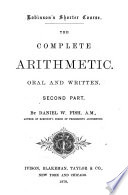 | Stoddard A. Felter - 1868 - 360 pages
...8 ft. X 2 = 16 sq. ft. Fig. 24. Prob. Hi — The sides of a triangle being given to find the area. Rule. — From half the sum of the three sides subtract each side separately, then multiply the continued product of these remainders by half the sum of the sides, and... | |
 | Isaac Todhunter - 1869 - 312 pages
...base, the quotient is the height. 152. The three sides of a triangle being given, to find the area. RULE. From half the sum of the three sides subtract each side separately ; multiply the half sum and the three remainders together : the square root of the product... | |
 | Anthony Nesbit - 1870 - 578 pages
...foregoing method. 4. When the three sides of a triangle are given, the area may be found as fol. Iowa : From half the sum of the three sides subtract each...sum and the three remainders continually together, and the square root of the last product will be the area required. This method is too prolix, except... | |
 | Hoy D. Orton - 1871 - 202 pages
...it makes the corner a true right-angle. To find the area of any triangle when the three tides only are given. RULE. — From half the sum of the three sides subtract each side severally; multiply these three remainders and the said half sum continually together ; 'hen the square root of the last... | |
 | Daniel W. Fish - 1874 - 302 pages
...What is the area of an isosceles triangle whose base is 20 ft., and each of its equal sides 15 feet 1 RULE. — From half the sum of the three sides, subtract each side teparately ; multiply the half -sum and the three remainders together; the square root of the product... | |
 | Daniel W. Fish - 1874 - 300 pages
...What is the area of an isosceles triangle whose base is 20 ft., and each of its equal sides 15 feet ? RULE. — From half the sum of the three sides, subtract each side separately ; multiply the half-surn ami the three remainders together; the square root of the product... | |
 | Lorenzo Fairbanks - 1875 - 472 pages
...chains, and the perpendicular 18.25 chains ? PROBLEM III. 710. To find the area of a triangle when three sides are given. RULE. — From half the sum of the three sides subtract each side separately. Then multiply the half sum and the three remainders continually together, and the square... | |
 | Horatio Nelson Robinson - 1875 - 468 pages
...of an isosceles triangle whose base is 20 ft., each of its equal sides 15 ft. ? Ans. 111.85 sq. ft. RULE, from half the sum of the three sides subtract each side separately ; multiply the half-sum and the three remainders together ; the square root of the product... | |
 | Henry Lewis (M.A.) - 1875 - 104 pages
...CASE II. — The area of a triangle may, however, be determined from its three sides by the following rule: — From half the sum of the three sides, subtract each side separately; then multiply the half sum and the three remainders together, and the square root of the... | |
 | George Albert Wentworth - 1877 - 416 pages
...figure. § 424 GEOMETRY. — BOOK V. EXERCISES. 1. The area of any triangle may be found as follows : From half the, sum of the three sides subtract each side severally, multiply together the half sum and the three remainders, and extract the square root of the product. Denote... | |
| |